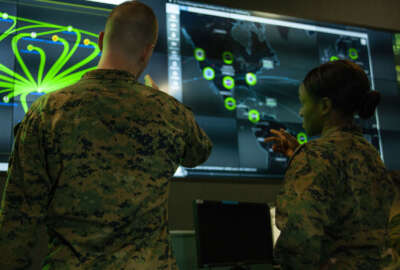
Now operational DoD chief digital and AI office will be an example of innovation, officials say
DoD admits it's not industry, but that just means it has a different way of getting things done.
The Defense Department’s newest office focusing on putting artificial intelligence at the forefront of much of what the military does is going to need to work within the established bureaucracy as it tries to move quickly and bring new companies to the Pentagon.
DoD’s chief digital and AI office (CDAO) has only been fully operational for several days, but its chief, Craig Martell, says he plans to hit the ground running by working with DoD’s famous bureaucratic processes to add 21st century value to the military.
Talking at the virtual DoD Digital and AI symposium on Wednesday, Martell said he’s already noticing the administrative slow down — he has yet to receive his access card to the Pentagon, and still needs to go through the visitor’s entrance. However, Martell said the point of his office is to use DoD’s power, even the frustrating parts, to expand AI capabilities.
“We’re not going to change the bureaucracy of the whole,” Martell said. “That’s not a challenge I want to put before the team. We need to find the right gaps, the right places where we can leverage value. That value is going to drive a virtuous cycle of change. There’s a lot of things about the DoD that can’t be more like industry. We shouldn’t try to force that square peg in a round hole, right? We need to find out how to keep it the DoD but also make it more efficient and work better.”
Deputy CDAO Marie Palmieri said the office will scale a different operating model for delivering digital technologies. The point of the office is to build end-to-end cohesion on everything from data collection and curation to advanced analytics that will give the agency an advantage in decision-making and operations.
“It really is a collective ecosystem. We had the parts of it, but [we’re] putting it together in a way we haven’t before to deliver that decision advantage that our leaders need,” DoD Chief Information Officer John Sherman said in February. CDAO brings together DoD’s Joint Artificial Intelligence Office, the Defense Digital Service the chief data officer and the Advancing Analytics planform Advana.
Despite trying to veer away from making DoD like industry, Martell has extensive Silicon Valley experience. It’s no surprise DoD chose the former head of machine learning at Lyft to head the CDAO. DoD often refers to its future military command and control plans by using ride sharing apps as an analogy.
“DoD uses ride-sharing service Uber as an analogy to describe its desired end state for JADC2. Uber combines two different apps — one for riders and a second for drivers,” the Congressional Research Service report on Joint All Domain Command and Control (JADC2) states. “Uber relies on cellular and Wi-Fi networks to transmit data to match riders and provide driving instructions. JADC2 envisions providing a cloud-like environment for the joint force to share intelligence, surveillance, and reconnaissance data, transmitting across many communications networks, to enable faster decision making.”
The CDAO will be heavily involved in JADC2 as DoD plans to inject the program with AI components to quicken that decision making.
Martell said part of his job will be easing the way for industry to bring in their technologies, especially ones that can be applied right off the shelf. That ease will be extended down to even the smallest companies.
“One of the things that I want us to spend a lot of time thinking about is how do we not just go to the big players?” Martell said. “How do we make it easy for other businesses too? How do we create a marketplace for startups, for medium-size, for small businesses? Because particularly in the AI space and I’m sure in many other spaces as well, there’s a lot of innovation happening in two-person shops or five-person shops. You know, a good brain with a good idea, we want to be able to leverage all of that.”
Deputy Defense Secretary Kathleen Hicks noted at the same conference that there is a massive innovation ecosystem focused on software in the United States and she wants the CDAO to tap into that.
“There’s a real a part of the impetus I had in the CDAO is there’s a power in bringing a vanguard organization with direct reporting relationship to me and to the secretary at the four star level that can push us in these areas,” she said. “They can build on work that’s been underway. We have a number of procurement vehicles already available. I think there’s five that are really focused on expanding our access in DoD to nontraditional companies.”
Hicks said she hopes the office can also bring in a talented workforce that wants to work for and stay with DoD. The CDAO will be an exemplar for people who want to innovate within government.
Copyright © 2025 Federal News Network. All rights reserved. This website is not intended for users located within the European Economic Area.
Scott Maucione is a defense reporter for Federal News Network and reports on human capital, workforce and the Defense Department at-large.
Follow @smaucioneWFED
Related Stories






